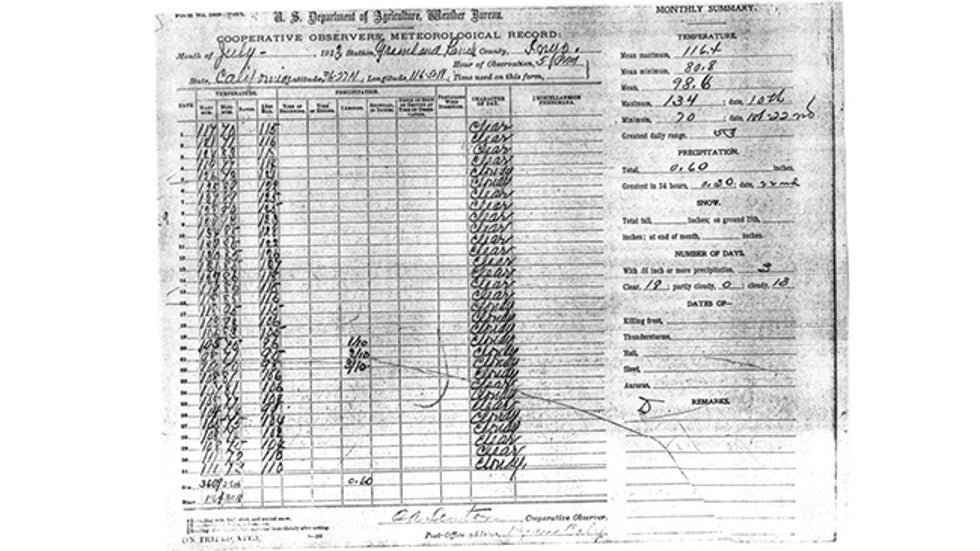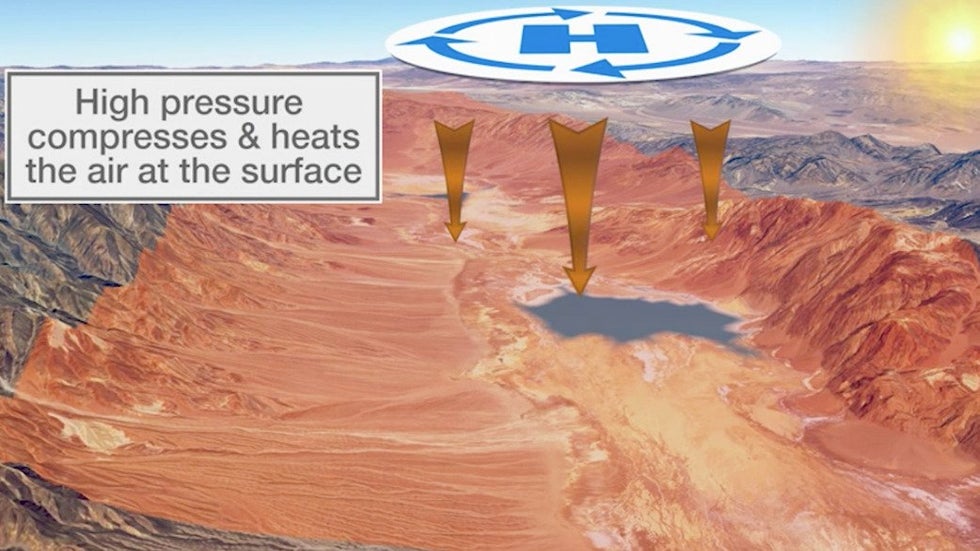Jonathan Erdman
Sign up for the Morning Brief email newsletter to get weekday updates from The Weather Channel and our meteorologists.
Death Valley, California, is not only America's extreme heat leader, but also holds a global record due to its extremely low elevation in the Desert Southwest.
Named by prospectors trying to cross the desolate valley during the California Gold Rush in the mid-19th century, Death Valley holds the world record hottest recorded temperature, 134 degrees, on July 10, 1913.
That became officially recognized by the World Meteorological Organization after an investigation led by weather historian Christopher Burt showed that a previous record of 136 degrees in Libya in 1922 was invalid.
 The thermometer at the Furnace Creek resort already read 120 degrees before noon in Death Valley National Park Friday, June 28, 2013 in Furnace Creek, California.
The thermometer at the Furnace Creek resort already read 120 degrees before noon in Death Valley National Park Friday, June 28, 2013 in Furnace Creek, California.That 134 Degree Record Is Suspect
This long-standing official record from 110 years ago is subject to controversy.
"I'm not just 90% sure it was not valid. I'm closer to 100% sure it was not valid," Burt said in an interview with weather.com in July 2023.
Burt noted surrounding observations show there wasn't an exceptional heat wave happening throughout the region around the second week of July 1913.
"So why did Death Valley suddenly become hotter than every other place with its all-time record high temperatures when no other site in the region came even close to their all-time record? That's a red flag," Burt said.
He also noted that the 134-degree observation didn't match up logically with temperatures at various elevations near Death Valley.
(IN DEPTH: An Investigation Of Death Valley's 134-Degree World Record)
 The observations taken at Greenland Ranch, today known as Furnace Creek, in Death Valley, California during July 1913.
The observations taken at Greenland Ranch, today known as Furnace Creek, in Death Valley, California during July 1913.If Not 134 Degrees, What Is The Real Record?
On July 26, 1931, Kebili, Tunisia, reportedly recorded a high of 55 degrees Celsius, or 131 degrees Fahrenheit. However, in an email to weather.com, Burt wrote "nothing (is) known about the provenance of this figure."
After the Tunisia and July 1913 Death Valley readings, the next hottest temperature measured on Earth still happened at Death Valley.
It hit 130 degrees there on Aug. 16, 2020, then again on July 9, 2021.
Unlike the 1913 readings, these temperatures were measured by an automated temperature sensor at Furnace Creek. It's rated to measure temperatures up to 158 degrees to an accuracy of 0.018 degrees and is regularly maintained, according to the National Weather Service in Las Vegas, which has forecast responsibility for Death Valley National Park.
 The official weather observation equipment at Furnace Creek, near Death Valley National Park's visitor center.
The official weather observation equipment at Furnace Creek, near Death Valley National Park's visitor center.Death Valley hit 129 degrees six different days after 1913, all in July in 2021, 2013, 2007, 2005, 1998 and 1960, according to NOAA's ACIS database.
According to Burt, the highest reliable surface air temperature on the planet outside of Death Valley happened in Mitribah, Kuwait, on July 21, 2016, when the temperature soared to 129 degrees (53.9 degrees Celsius).
This heat seems incomprehensible to most of us who may sweat through a 90-degree day.
Even Death Valley's unofficial record high is 9 degrees hotter than the hottest temperatures measured in the Plains during the 1930s "Dust Bowl," 8 degrees hotter than the all-time record high at Phoenix Sky Harbor Airport, and approximately the recommended cooking temperature for a rare to medium-rare steak.
Typical Death Valley Heat
Death Valley's heat, even in an average year, is likely beyond anything most have experienced before.
Consider these eye-popping statistics:
- Average number of 100 degree or hotter days per year: 147.
- Average first/last date of 100-degree heat: April 14/Oct. 12.
- Average number of 80 degree or hotter daily lows per year: 92.
So, just under five months of the year, you can expect a triple-digit high at Death Valley's Furnace Creek, and three months out of the year, morning low temperatures don't drop below 80 degrees.
Now, let's really turn the heat up.
- Average number of 120-degree-plus days per year: 23.
- Average number of 90-degree-plus daily lows per year: 32.
- Average number of 100-degree-plus daily lows per year: 1.
 Cheng Jia, of China, takes a picture of Yongxin Yan by a digital thermometer at the Furnace Creek Visitor Center in Death Valley National Park Friday, June 28, 2013 in Furnace Creek, Calif.
Cheng Jia, of China, takes a picture of Yongxin Yan by a digital thermometer at the Furnace Creek Visitor Center in Death Valley National Park Friday, June 28, 2013 in Furnace Creek, Calif.To place 120 degrees into perspective, that is the all-time state record high in Arkansas, Oklahoma, South Dakota and Texas.
Again, these are average conditions in Death Valley.
The Not-As-Infamous Records
Now, let's detail some other factoids about Death Valley's weather, including its incredible lack of precipitation – also a contributor to its extreme heat.
- A temperature of 201 degrees was measured on the ground surface on July 15, 1972. That's just 11 degrees shy of the boiling point of water. The air temperature that day reached 128 degrees.
- On July 5, 1918, the daily low temperature only dropped to 110 degrees, a world record hottest daily low. That's higher than the all-time high temperature in six New England states plus New York, Maryland, Florida, Alaska and Hawaii.
- On April 22, 2012, Death Valley soared to 113 degrees, the hottest April temperature on record anywhere in North America.
- In 1929 and 1953, no rain was recorded in Death Valley. For 40 straight months between 1931 and 1934, less than 1 inch of rain fell - 0.64 inches, to be exact - in what is still its longest dry spell on record.
 Runners gather for a photo at largely dried-out Badwater Basin before the start of the 135-mile Kiehl's Badwater Ultramarathon in July 2007 in Death Valley National Park in southeastern California.
Runners gather for a photo at largely dried-out Badwater Basin before the start of the 135-mile Kiehl's Badwater Ultramarathon in July 2007 in Death Valley National Park in southeastern California.Why Is It So Hot in Death Valley?
Furnace Creek, home of the Death Valley National Park Visitor's Center where the official temperature reading is taken, is roughly 190 feet below sea level.
Since air warms as it descends, that extra elevation plunge adds extra heat.

The valley is surrounded by mountains on all four sides, which also heat up in the desert sun. On a typical day, when the valley floor heats up, instead of mixing with cooler air from above, it mixes with still quite hot air just above it. In this way, heat can become trapped in the valley.
Because of that surrounding mountainous terrain, just 2.23 inches of precipitation falls each year in the valley, on average. Contrast that to the average evaporation rate of 150 inches a year. No wonder it's a dry lake bed.
Most Pacific storm systems have the lion's share of their moisture taken away by four mountain ranges to the west of Death Valley. Their wettest month, February, averages only 0.53 inches of precipitation.
The valley is also just far enough north to miss out on most - but not all - of the summer monsoon thunderstorms that are more numerous over Arizona and adjacent Four Corners states.
This bone dry desert virtually devoid of vegetation means virtually all of the sun's energy that isn't reflected goes to heating the ground and the air above it, rather than evaporating or transpiring water or moisture.
A Legacy of Flooding
Amazingly, despite this desert environment, destructive floods are not uncommon.
In early August 2022, one such massive flash flood damaged and closed all roads in the national park.
While the daily total of 1.70 inches of rain at Furnace Creek doesn't sound like much, it was about 75 percent of their average yearly rain. And it fell in just a few hours. When that happens in a desert, normally dry washes and arroyos become damaging torrents of water and debris.
A bizarre pair of flash flood events in October 2015 washed out the main road to Scotty's Castle in the park, as well as damaging some infrastructure and outbuildings on the castle grounds, leaving several feet of mud and rocks inside.
According to the National Park Service, Scotty's Castle picked up around 3 inches of rain in just five hours. That spot averages only about 4 inches of precipitation the entire year.
It was considered the greatest flood event at Scotty's Castle since it was built in the 1920s.
On Aug. 15, 2004, torrential rain sent walls of floodwater up to 8 to 10 feet deep through parts of the park.
Miles of roads were washed out and closed for months. Cars were swept away and buried. Two people were killed near Zabriskie Point. The park was closed for nine days and was considered the costliest Death Valley weather event at the time, with damage estimated at $20 million, according to the National Weather Service.
The wet weather continued into the following winter, filling the typically dry salt flats of Badwater Basin with up to two feet of water, allowing kayakers to enjoy the joy of paddling the new, small lake into early spring 2005, according to NWS-Las Vegas.
Other destructive floods occurred in 1987, 1984 and 1976, among other years.
Yes, It Even Can Snow
Only once on record has measurable snow fallen on the valley floor, when 0.5 inch of snow was recorded at Greenland Ranch, the official recording station on January 29, 1922.
NWS-Las Vegas official records say a trace of snow was recorded on three other dates, most recently January 4-5, 1974, and January 22, 1962.
A prolonged cold snap in January of 1949 also deposited trace snow amounts in the valley, briefly covering the ground at Furnace Creek Ranch before melting.
That same event, however, dumped 4 inches of snow at Cow Creek from January 10-11, 1949, the heaviest known snowfall below sea level in the park, according to NWS-Las Vegas.
Jonathan Erdman is a senior meteorologist at weather.com and has been an incurable weather geek since a tornado narrowly missed his childhood home in Wisconsin at age 7. Follow him on Twitter and Facebook.
The Weather Company’s primary journalistic mission is to report on breaking weather news, the environment and the importance of science to our lives. This story does not necessarily represent the position of our parent company, IBM.
The Weather Company’s primary journalistic mission is to report on breaking weather news, the environment and the importance of science to our lives. This story does not necessarily represent the position of our parent company, IBM.

No comments:
Post a Comment